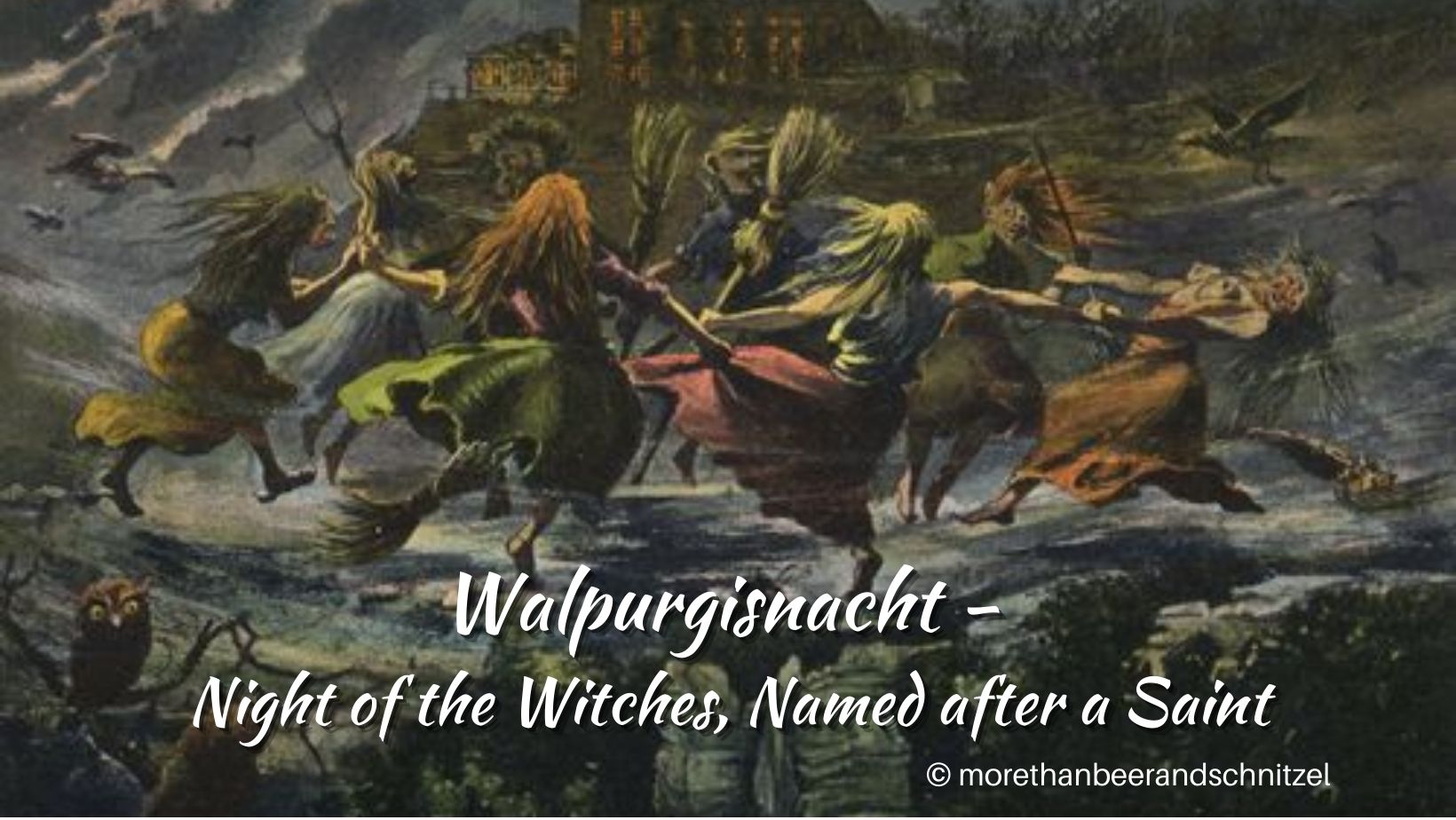The night from April 30 to May 1 is called Walpurgisnacht in Germany, and sometimes also Hexennacht (witches’ night). It has its roots in the Celtic spring celebration of Beltane. It is said that the witches meet on the Brocken (also called Blocksberg, the highest peak in the Harz mountain range ) to dance around a fire and mate with the devil or kiss his bare behind.
It is based on the Hexensabbat (Witches’ Sabbath), a term popularized in the early 15th century and consists of the same elements of the Walpurgisnacht but not linked to a specific day.
The question is now how did Saint Walburga get associated with witches?


Saint Walburga
Saint Walburga (also Walpurga) was born in 710 CE in Wessex, England, probably into a noble, but at least wealthy family. She is said to have been the daughter of the Christian king Richard of Wessex (also Richard the Pilgrim) and the niece of the Holy Boniface. When Walburga was 10 or 11, she became an orphan and was raised and well educated in a monastery Wimborne in Dorset.
Two of her brothers went to continental Europa as missionaries, Wunibald to Heidenheim and Willibald to Eichstätt. Walburga, now a nun, followed them. During the journey across the Channel, the boat got caught in a major storm, and Walburga prayed the whole night until they safely reached Antwerp. Because of this ‘miracle’ she is the Patron Saint of seafarers and against storms.
Walburga settled in Tauberbischofsheim and when her brother Wunibald died in 761 she took over the monastery he founded in Heidenheim. Soon a women’s monastery was added and Walburga was the abbess of both. That’s why she is often depicted with a staff.


Her miracles
There are multiple miracles Walburga performed: she saved a kid from starving with three grain ears, and she calmed a dog gone mad with rabies. She is also said to have healed people and especially women who were close to dying from childbed fever. She is therefore the patron against pestilence, coughing and rabies, as well as the patron saint for new mothers.
Since 1042, water from her grave slab in Eichstätt is collected and this Walburgisöl is said to have healing powers. Many people had special boxes to hold their flasks with the healing water. The oil still flows today is collected and can be acquired at the monastery for a donation.

Walburga died on February 25, 779 (probably) in Heidenheim. That’s also her Feast Day in the Catholic Church.
Since 2021, the worship practices for Saint Walburga have an Intangible Cultural Heritage of Bavaria.

The connection to "Walpurgisnacht"
So, what’s so significant about May 1, she wasn’t born on that day and neither did she die?
It is said that she was canonized by Pope Hadrian II on May 1, though this information can’t be verified. May 1 is also the day when her relics were translated from Heidenheim (where she died) to Eichstätt in 870. 23 years later, some relics were taken by the nun Liubila from Eichstätt to Monheim (Swabia) to the monastery Liubila had founded. On the way, many miracles happened.
So, there we are: Saint Walburga has nothing to do with witches. The only other possible connection could be that Walburga was the patron saint of women who had just given birth. Witches, or rather women accused of being witches, were knowledgeable about herbs and worked as midwives in the villages and towns.
But other than that, the night is named after her because her relics were being moved and the Pope possibly canonized her on May 1.
Walpurgisnacht
As I said before, Walpurgisnacht and the activities supposedly going on there are based on the stories about Hexensabbat. The name Walpurgisnacht was popularized by Goethe’s “Faust” (1808), a play in which Dr Faust makes a pact with the devil Mephistopheles. In the play the carnal night takes place on the Brocken in Saxony-Anhalt.


The first Walpurgisnacht celebration (for mortals and non-witches) was organized in 1896 by Rudolf Stolle, a publisher. Interestingly, only men attended the event that took place on the Brocken. Over the years, the celebration expanded to include more people (probably also women), a Walpurgishalle (hall) was built on the Hexentanzplatz (dance area). The hall had an old germanic touch to reference the spring celebrations from earlier times when people of the region which included sacrifices to the Germanic god Wodan. Supposedly, Brocken was also the place where Wodan married Freya.



Special trains of the Brocken Railway (Brockenbahn) were organized to get people to the Brocken. Today, multiple communities around the Blocksberg, as the Brocken is colloquially called, come together to organize Walpurgisnacht events.
It is also common in the region around the Brocken to decorate with witches and for the festivities to dress up as a witch or the devil. They also just refer to the night as Walpurgis.

Other Celebrations
Many towns have parties and events on April 30. May 1st (May Day, Tag der Arbeit, Labor Day) is a public holiday in Germany, so many communities have parties called Tanz in den Mai (dance into May) that may or may not involve a Maifeuer (May Fire), Maibaum (May Pole), and singing of “Der Mai ist gekommen”.



Only registered users can comment.
Comments are closed.